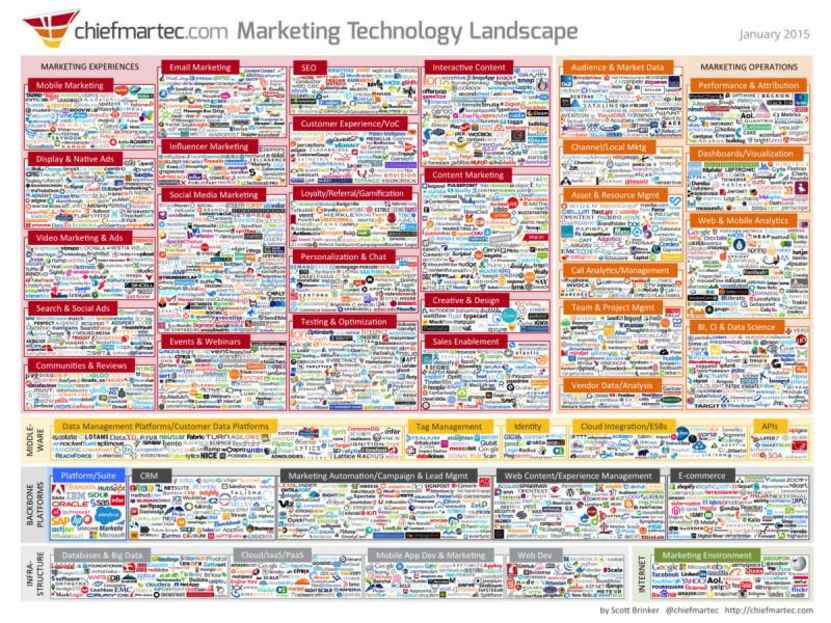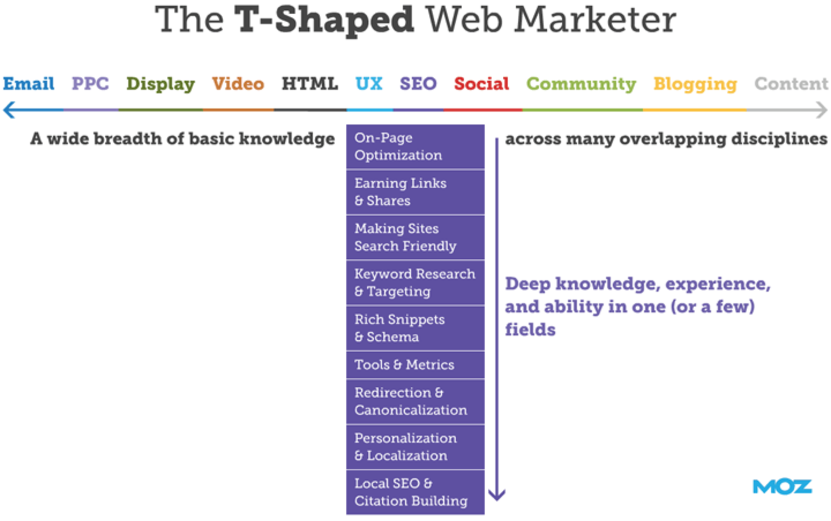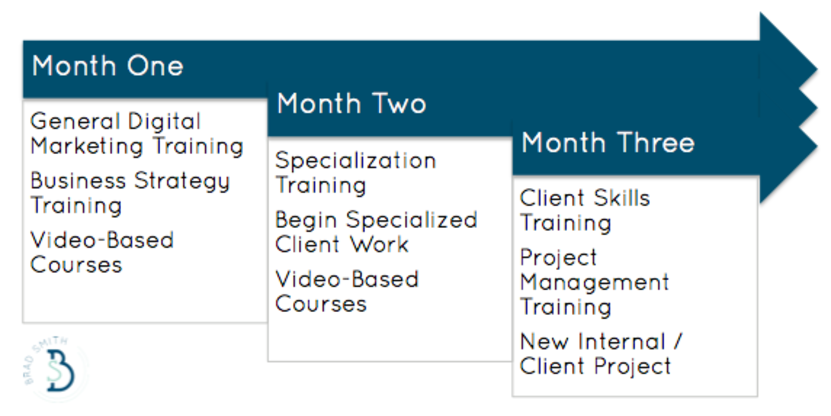So You Want to Be a Content Marketing Unicorn?

Did you know that roughly half of your customer interactions are multi-devices or multi-channel?
For example; someone hears your ad spot on Spotify before doing a quick search query for a product via Google. They click on your ad which sends them to a landing page. They opt-in via your lead capture form and are then exposed to your carefully crafted sequence of emails that nurture their interest all the way through to making a purchase.
Everything working nicely together, for the greater benefit of your organization.
A whopping 95% of marketers say that they know how important multi-channel is for targeting.
So what’s the problem?
Only 14% of companies are actually coordinating their marketing campaigns in different channels according to CMO by Adobe.
The technology isn’t the problem by the way. There are now over 2,000 marketing technology platforms today to choose from. Most integrate with other systems and technology seamlessly.
On this page:

(Core dna is in there somewhere. Tweet at us if you found us)
The problem comes down to the old joke spouted by IT support desk teams. You know the one - PEBCAK. Problem Exists Between Chair and Keyboard. In this case, we’re talking about the modern marketer and a misaligned skill set for modern marketing problems.
Here’s how to create, cultivate, and grow expert content marketers for our new era.
The T-Shaped Marketer (As a Framework)
SEO used to be easy in the good old days.
You threw some white keywords on a white background, purchased (or swapped) some links, sprinkled some magic Google dust (jk), and waited until the visitors (and money) poured in.
Unfortunately for marketers (consumers rejoice!), that’s not the case anymore.
A slew of zoo animals including Pandas, Penguins, and Hummingbirds have swept through and altered the landscape.
SEO tactics look a bit different today as well. Someone with 15+ years of SEO experience may not have evolved either, still trying to force the same old playbook into this new world (making the quantity of experience alone an irrelevant figure in digital marketing).
Today, it takes a diverse skill set to properly execute even a single SEO campaign. You need to understand how to develop customer personas, create a blog, setup information architecture, create ‘skyscraper’ content, get high-quality links, and more.
How can you possible hire, let alone train, someone for this new environment?
The best example I’ve seen is the T-shaped marketer, a theory developed by much smarter people than myself.
The objective is to build a broad set of skills in various areas, so you understand how all the pieces fit together. You need not be an expert in all but do develop a deeper knowledge to allow more focus in one or two of these areas.

Rand Fishkin from Moz does an excellent job highlighting some of the benefits of this approach in this post about T-Shaped Marketers:
1. Ability to Understand
Succeeding in this brave new world requires a strong working relationship with people from a range of backgrounds. For example, having an ability to understand and communicate with a developer on their level will enable you to get much better outcomes than speaking through a go-between who has to translate for you.
Being more versatile in this respect enhances your chances of coming up with creative solutions to tough problems through combined expertise.
2. Satisfies our Innate Drive
Blasting out generic, untargeted email communications on a daily basis isn’t the most rewarding work. Rand cites Daniel Pink to show that people crave mastery, which deep domain knowledge can bring over time.
This T-Shaped model brings together the (a) spontaneity and freshness of working across multiple disciplines, but (b) also allows for specialization to satisfy that deeper learning for the best and brightest digital marketers.
3. (Good) Redundancies
Having only one person in your organization who understands those complex lead nurturing email workflows puts you at an extreme disadvantage. Instead of ‘siloing’ information, having people with overlapping skills allows them to help each other out and stay on top of what the entire team is trying to accomplish – pitching in where appropriate or covering for another colleague in a pinch.
Others have echoed these same sentiments, with a particular focus on the need for technical skills.
Way back in 2022 (which feels like a couple of decades in “Internet Years”), Jamie Steven argued that every marketer should be technical because “You have to know what to ask for and how it’s done. Without both of these capabilities, you’re prone to be less efficient than a colleague or competitor who does”.
In other words, that’s what separates the Unicorns from everybody else.
It’s easy to verify this too.
Pull up Glassdoor or any other major job listing site.
Take a look at the requirements for a Digital Marketing Manager with POM Wonderful (you know, the pomegranate juice in the funny but awesome bottle):

Let’s recap. The individual they are looking for needs to:
- be strong in social trends and measurement.
- understand digital media buying at an expert level.
- have complete mastery of the latest Search (both Paid and Organic) techniques.
- have strong analytical skills.
- be fluent in how these affect CRM and loyalty programs.
- have a working knowledge of UX, content production and more.
- have technical ability to understand what HTML can and can’t do.
No pressure or anything.
Or how about this one from Outdoorsy on Inbound.org:

Again, one lucky guy or gal who will get to ‘growth hack’, lead PPC, Social, Email Affiliate and Partner marketing. All at the same time, perhaps whilst juggling and chewing gum. Talk about a lot of hats!
The point is, the marketing landscape has never been more fractured or complex. It now takes a variety of touch points in multiple channels on various devices to eventually get someone to buy (and buy again).
That means the marketers running those campaigns need to be well versed in all of these different techniques too.
This doesn’t even begin to touch on all of the ‘soft skills’ critical to the job either. Like if you’re jumping on the social media front lines and responding to angry customers. Or trying to explain to a new client (or boss) exactly how that new content budget is going to drive backlinks, social mentions, and someday, hopefully, new customers. Or just being a good human that gets along with people and colleagues enjoy working alongside.
It at all sounds impressive (and daunting) in theory. But how are you supposed to manage all of those skills at once?
How to Build T-Shaped Marketers
Finding good people with this diverse skill set is tough.
Entry-to-mid level marketers typically don’t come ready-made with a basic working knowledge of the intricacies between:
- Business and marketing strategy
- Content creation and production
- Basic technical skills
- Search (SEO) principles
- Social, PR, and outreach
- Paid acquisition
- CRO and landing page optimization
- Analytics to tie everything together
On top of that, you need people who are autonomous, naturally curious, and doggedly persistent.
You can’t screen for this on an application. And it’s tough to sense in an interview.
But you can verify it with a test project.
Hiring
An initial interview is a helpful determinant of cultural fit. You can get a pretty good sense from most candidates, fairly quickly, whether or not they’ll be a good, amiable character to work with and whether or not they’ll fit in around the place.
But let’s be honest. Your first interview is not the venue for a surprise skill tester. You are not going to get the best out of people by trying to stump them because that is not how the real world works once they get into their marketing role. What matters is their thought process, creativity, and ability to be resourceful in using the tools at their disposal.
Instead of trying to trick candidates try to get an idea of how they work. You might even consider giving them a PAID task to see how they work in a real rather than hypothetical situation. Give them an overview of what they’ll be doing, give them a few days to prepare (to create some urgency), and let them know we’re not expecting perfection. Remember, you are testing process and thinking, not the absolute solution.
Pick an actual client project so the stakes are real, and then create a simple outline to weave together the major disciplines they might eventually touch.
The goal would be to simultaneously:
- Get a feel for how they think and work.
- Assess their ability ‘in the weeds’ on tactical decisions
- See if they can pull all the details together into one cohesive campaign (and communicate that vision back to you)
So you might want to pick one or two activities along the entire customer journey, from creating AdWords text to setting up form opt-ins for the newly generated lead.
Have them create new pages on a client’s website, get their hands dirty with basic API integrations or use of tools like Zapier, to see how they can solve problems in real-time.
Give them clues (like hinting at ‘message match’) hopefully sends them to Google (if they don’t already know what it is) to do some basic research on what that is and how to abide by it.
In fact, this is also the same approach we take at Core dna when bringing on new hires.
Our Digital Marketing Manager, Edward Dennis was tasked with creating a presentation for the management team, to present new campaign ideas for a real client. It also included actually writing a blog post out to make sure he could execute on his ideas.
Believe it or not, teaching these technical skills is the easy part. The tough part is seeing if they can figure things out on the fly, understand the big picture of how these concepts connect, but still dive into the weeds on a few when necessary.
Training
People learn best by doing. Throwing them in the deep end, but being there to support and mentor, can help stretch them to get up to speed quickly.
Research has also shown that “a well-planned program delivery system including the opportunity to see, experience, and discuss should greatly enhance the learning process”.
Our approach attempts to balance theory (lecture-style) with experience (our anecdotal evidence) and real-world learning (actual client projects) over the first 60-90 days.

For example, in Month 1 you might focus on:
- General Digital Marketing Training: Depending on how the initial test project went, you can tell which areas they’re already strong in and which they might need a little more help.
- Business Training: The most successful marketing strategies are rooted in business strategies. Lacking that foundation means you get people who like chasing trends instead of understanding how real businesses grow and function.
- Video-Based Courses: Structured learning on theory in different areas to round out their general knowledge.
Months two and three then would focus on more specialized work (including in our case, client skills like how to manage project expectations, answer uncomfortable questions, and how to sell).
Fortunately, there’s a growing number of excellent ready-made course that can help supplement everything else they’re working on. A few of my favorite include:
- Treehouse: If the thought of getting knee-deep in code sounds about as fun as a root canal, the experience on Treehouse can be your novocaine.
- Distilled U: A deep dive into the expanding world of SEO, including introductory topics on Excel and HTML to increase people’s productivity.
- Moz Training: Select workshops on SEO tactics like keyword research, but also more diverse subjects like content marketing. Even their free webinars (or ‘Mozinars’) are excellent.
- Digital Marketer: A variety of different products and programs on diverse topics such as social media, conversions and more.
- Conversion Copywriting 101: All of the Copy Hacker’s books are well worth the investment. However, this initial free training is a great primer to get someone up-to-speed on a difficult topic.
- Lynda: Although most of Lynda’s content seems aimed towards beginners, it can still serve as a decent introduction to new topics you (or your team) might be unfamiliar with).
- ClickMinded: ClickMinded has a free SEO video mini-course that will quickly give you a high-level overview of how SEO fundamentally works, taught by the former SEO manager from Airbnb
If the only way to eventually learn this stuff is by doing it, ideally, we want to get new people doing real work as quickly as possible.
For us, that usually means finding new projects or small accounts that they’ll lead (even though they technically might not be ready for it).
Putting new people in a position of responsibility forces them to work with others, interface with clients, see what does and doesn’t work, and screw up (on a small, limited scale).
Conclusion
Our multi-channel, multi-device world shows no signs of slowing down.
The trouble is that it also means the people running campaigns across all of these various touch points need to understand how it all works together.
The T-shaped marketer model is one of the best examples of how this should look in reality, with a breadth of knowledge in various areas and specialization in a few core ones. It also mirrors the myriad responsibilities and expectations that many companies have of digital marketers today.
Hiring people capable of this is tough, but can be made easier by using real-life test projects that provide a real assessment of the ‘intangibles’ it takes to stay up to speed.
Combined with a comprehensive training structure, these individuals should flourish when given the chance to show what they’re made of.
None of this is easy. But then again, the outsized return that Unicorn businesses (and the marketers driving them) see, makes it all worth the effort.













